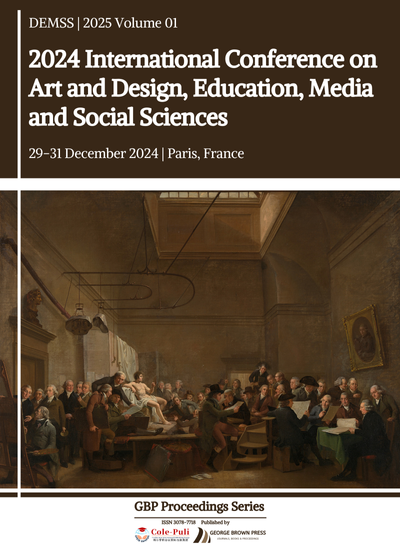Research on Innovative Models of New Media Art and Personalized Education
DOI:
https://doi.org/10.71222/fsd25m61Keywords:
new media art, personalized education, technological advancements, cultural impactAbstract
This paper delves into the synergy between New Media Art and personalized education, assessing how the fusion of digital art and educational practices can revolutionize learning experiences. New Media Art, characterized by its use of digital technology and interactivity, offers a dynamic platform for engaging students in a more personalized and immersive educational environment. The study underscores the significance of personalized education in the 21st century, where the demand for creativity, critical thinking, and problem-solving skills is escalating. It examines the cultural impact of New Media Art, which extends beyond the art world to influence societal values and norms, and how it challenges traditional definitions of art to foster a more inclusive dialogue. Technological advancements such as augmented reality, virtual reality, and artificial intelligence are reshaping the landscape of New Media Art, providing new avenues for artistic expression and educational engagement. The paper discusses the challenges and potential solutions in implementing New Media Art in educational settings, emphasizing the need for overcoming technological and pedagogical barriers. In conclusion, the integration of New Media Art into personalized education models is posited as a promising direction for educational innovation, capable of transforming learning experiences to be more engaging, relevant, and effective, preparing students for the dynamic digital world.
References
1. Cristache, N., Pricopoaia, O., Năstase, M., et al. "The Metaverse, a New Frontier for Innovative Business Models." Technol. Forecast. Soc. Chang., 2024, 209, 123838-123838, doi: 10.1016/j.techfore.2024.123838.
2. Alyami, M., Onyelowe, K., AlAteah, H. A., et al. "Innovative Hybrid Machine Learning Models for Estimating the Compressive Strength of Copper Mine Tailings Concrete." Case Stud. Constr. Mater., 2024, 21, e03869-e03869, doi: 10.1016/j.cscm.2024.e03869.
3. Krzywanski, J., Czakiert, T., Nowak, W., et al. "Towards Cleaner Energy: An Innovative Model to Minimize NOx Emissions in Chemical Looping and CO2 Capture Technologies." Energy, 2024, 312, 133397-133397, doi: 10.1016/j.energy.2024.133397.
4. Babos, A., Orbán, A., Benkő, M. "Innovative Housing Models to Support Shared Use of Space: The Case Study of Sonnwendviertel Ost in Vienna." City Territ. Archit., 2024, 11(1), 24-24, doi: 10.1186/S40410-024-00242-8.
5. Li, J., Deng, G., Li, X., et al. "An Innovative Electrical Neurostimulation Approach to Mimic Reflexive Urination Control in Spinal Cord Injury Models." Sci. Rep., 2024, 14(1), 25305-25305, doi: 10.1038/S41598-024-76499-3.
6. Jose, P. A., Kaushik, A., Tange, H., et al. "Redesigning Telemedicine: Preliminary Findings from an Innovative Assisted Tele-medicine Healthcare Model." BMC Prim. Care, 2024, 25(1), 380-380, doi: 10.1186/S12875-024-02631-X.
7. Shao, M., Gao, Y., Xu, X., et al. "Expediting the Development of Robust 5-FU-Resistant Colorectal Cancer Models Using Inno-vative Combined In Vivo and In Vitro Strategies." Biomed. Pharmacother., 2024, 180, 117576, doi: 10.1016/J.BIOPHA.2024.117576.
8. Juteau, S. "TheFork by TripAdvisor: A French Success Story." J. Inf. Technol. Teach. Cases., 2024, 14(2), 174-179,doi: 10.1177/20438869231179989.
9. Wang, Z., Wu, P., Li, M., et al. "Perceived Effectiveness of the Person-Environment-Occupation Innovative Teaching Model in Rehabilitation Therapy Students." BMC Med. Educ., 2024, 24(1), 1180, doi: 10.1186/S12909-024-06196-2.
10. Ahmed, U., Jiangbin, Z., Almogren, A., et al. "Explainable AI-Based Innovative Hybrid Ensemble Model for Intrusion Detec-tion." J. Cloud Comput., 2024, 13(1), 150-150, doi: 10.1186/S13677-024-00712-X.
11. Zhu, C., Wang, M., Guo, M., et al. "Innovative Approaches to Solar Energy Forecasting: Unveiling the Power of Hybrid Models and Machine Learning Algorithms for Photovoltaic Power Optimization." J. Supercomput., 2024, 81(1), 20-20, doi: 10.1007/S11227-024-06504-Z.










